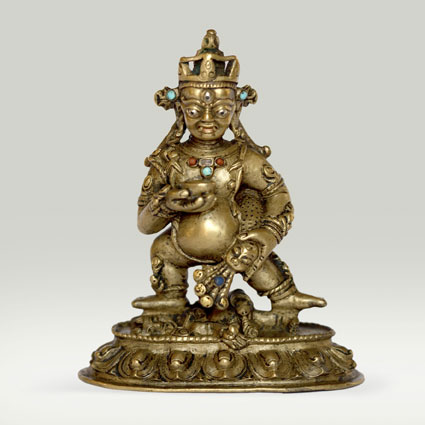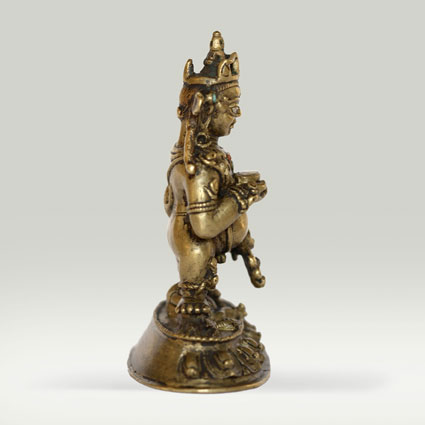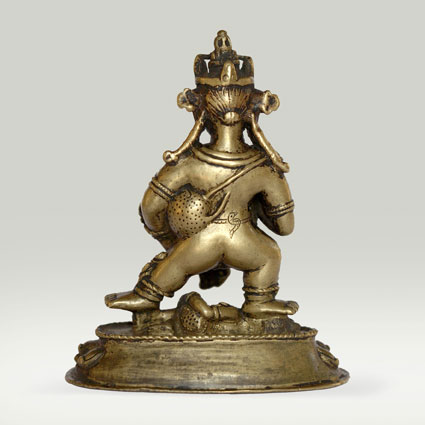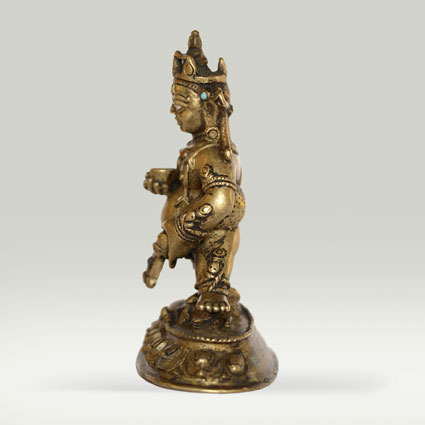ABS 213
Code: ABS 213
Country: Tibet
Style:
Date: 1300 - 1400
Dimensions in cm WxHxD: 8.5 x 10.4 x 4.4
Materials: Brass
The black Jambhala (Tib.: dzam bha la, nag po), God of wealth
Three-eyed, corpulent and clad only in a loincloth, yet adorned with jewels, the god of wealth is holding the gem-spouting mongoose (nakula) in his left hand. Typical of wrathful protecting deities, his smile with the glinting canines and dilated eyes gives him a menacing appearance. He stands in the warrior stance over a human body. This symbolizes that he subdues the human ego and eliminates human greed. At the same time, he benefits the poor as well as those in solitary retreat that have a virtuous mind. The right hand holds a skull cup in front of his chest. His jewellery is set with turquoise and coral, and he wears a snake necklace.
The mantras of the Black Jambhala are: Om Jambhala Jalendraye Bashu Dharini Svaha and Om Indzali Mu Kam Dzamali Soha
Both Kubera (in Hindu-religions) and Jambhala are linked to Vaishravana, even though they each can appear under different aspects. Under the name of Vaishravana, the deity is one of the guardians of the cardinal directions, and reigns over the north. Under the name of Kubera, he is the god of wealth. He wears the five-fold bodhisattva crown and carries the banner of victory with the wish fulfilling jewel in his right hand. Sometimes he rides on a snow lion. In Tibetan Buddhism he appears under the name of Jambhala. He is a protector in all the lineages, and is considered to be an emanation of Avalokiteshvara (tib.: Chenrezig), representing compassion and generosity. Jambhala appears under five different forms and colours, and each is linked to one of the five victorious Buddhas, showing different attitudes and attributes. The yellow Jambhala is the most popular. The jewel-spitting mongoose is always present, and clearly identifies these deities of wealth.
Wealth is considered to provide freedom, so that one may focus on the path of spirituality rather than on materiality and worries about the temporality of wealth.
The puja dedicated to the five Jambhalas is believed to summon positive wealth energies upon the participants. Even though wealth is supposed to result from one’s past actions, it is nevertheless believed that this puja can play a significant role in changing the course of one’s financial situation.
Three-eyed, corpulent and clad only in a loincloth, yet adorned with jewels, the god of wealth is holding the gem-spouting mongoose (nakula) in his left hand. Typical of wrathful protecting deities, his smile with the glinting canines and dilated eyes gives him a menacing appearance. He stands in the warrior stance over a human body. This symbolizes that he subdues the human ego and eliminates human greed. At the same time, he benefits the poor as well as those in solitary retreat that have a virtuous mind. The right hand holds a skull cup in front of his chest. His jewellery is set with turquoise and coral, and he wears a snake necklace.
The mantras of the Black Jambhala are: Om Jambhala Jalendraye Bashu Dharini Svaha and Om Indzali Mu Kam Dzamali Soha
Both Kubera (in Hindu-religions) and Jambhala are linked to Vaishravana, even though they each can appear under different aspects. Under the name of Vaishravana, the deity is one of the guardians of the cardinal directions, and reigns over the north. Under the name of Kubera, he is the god of wealth. He wears the five-fold bodhisattva crown and carries the banner of victory with the wish fulfilling jewel in his right hand. Sometimes he rides on a snow lion. In Tibetan Buddhism he appears under the name of Jambhala. He is a protector in all the lineages, and is considered to be an emanation of Avalokiteshvara (tib.: Chenrezig), representing compassion and generosity. Jambhala appears under five different forms and colours, and each is linked to one of the five victorious Buddhas, showing different attitudes and attributes. The yellow Jambhala is the most popular. The jewel-spitting mongoose is always present, and clearly identifies these deities of wealth.
Wealth is considered to provide freedom, so that one may focus on the path of spirituality rather than on materiality and worries about the temporality of wealth.
The puja dedicated to the five Jambhalas is believed to summon positive wealth energies upon the participants. Even though wealth is supposed to result from one’s past actions, it is nevertheless believed that this puja can play a significant role in changing the course of one’s financial situation.






